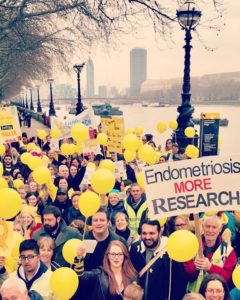Endometriosis is a common, often painful disorder of the female reproduction system. It is estimated that 10-15 percent of women in their reproductive years suffer from the condition.
 The endometriosis condition affects the tissue that normally lines the uterus, called endometrium. The tissue can become implanted outside the uterus, most commonly on the fallopian tubes, the ovaries or the tissue lining the pelvis. The endometrial tissue outside the uterus responds to the menstrual cycle the same way as the tissue inside the uterus—it swells and thickens, then sheds to mark the beginning of the next menstrual cycle. When the tissue outside the uterus thickens, it has no where to go, resulting in pools of blood that lead to inflammation and, eventually, scar tissue that can block the fallopian tubes, interferes with ovulation and may causes cysts.
The endometriosis condition affects the tissue that normally lines the uterus, called endometrium. The tissue can become implanted outside the uterus, most commonly on the fallopian tubes, the ovaries or the tissue lining the pelvis. The endometrial tissue outside the uterus responds to the menstrual cycle the same way as the tissue inside the uterus—it swells and thickens, then sheds to mark the beginning of the next menstrual cycle. When the tissue outside the uterus thickens, it has no where to go, resulting in pools of blood that lead to inflammation and, eventually, scar tissue that can block the fallopian tubes, interferes with ovulation and may causes cysts.
Traditional, allopathic medicine has not identified a cause of the disease. One theory suggests that during menstruation some of the menstrual tissue backs up through the fallopian tubes into the abdomen where it implants and grows.
Hormone Treatment
Natural medicine has identified a link between the hormone estrodial and the development of the disease.
With female hormone-related conditions, an estradiol excess (which can occur by taking oral contraceptives or other synthetic forms of estrogen) often is found to be part of the patient’s physiology. Hormone balancing and our understanding the development of the disease may be closely linked to this factor is at the basis of our treatment.
Endometriosis Treatment
The most common symptom of endometriosis is pain. The pain usually begins a day or two prior to the menstrual cycle and continues during menstruation. There can be occasional heavy periods or bleeding between periods, pelvic pain during ovulation, sharp deep pain in the pelvis during intercourse, pain during bowel movements or urination, and possible infertility.
Conventional medical endometriosis treatments may help relieve the symptoms of endometriosis but they do not address the root of the problem. Discover how we fight endometriosis at Sunridge Medical with natural medicine treatments that are the best way to fight endometriosis.
At Sunridge Medical, our highly-trained physicians are experts in providing an integrated approach to the treatment of cancer and chronic disease. Our treatment plans are individualized, and involve both traditional and alternative medicines.
The physicians at Sunridge Medical have found that symptoms frequently can be improved and even reversed with our natural treatments. We take a holistic approach to patient care and strive not only treat the disease, but also alleviate symptoms, increase quality of life and, most importantly address the underlying cause of disease.
References on Endometriosis
Vallée, A., & Lecarpentier, Y. (2020). Curcumin and Endometriosis. International journal of molecular sciences, 21(7), 2440. Endometriosis is one of the main common gynecological disorders, which is characterized by the presence of glands and stroma outside the uterine cavity. Some findings have highlighted the main role of inflammation in endometriosis by acting on proliferation, apoptosis and angiogenesis. Oxidative stress, an imbalance between reactive oxygen species and antioxidants, could have a key role in the initiation and progression of endometriosis by resulting in inflammatory responses in the peritoneal cavity.
Nevertheless, the mechanisms underlying this disease are still unclear and therapies are not currently efficient. Curcumin is a major anti-inflammatory agent. Several findings have highlighted the anti-oxidant, anti-inflammatory and anti-angiogenic properties of curcumin. The purpose of this review is to summarize the potential action of curcumin in endometriosis by acting on inflammation, oxidative stress, invasion and adhesion, apoptosis and angiogenesis. https://doi.org/10.3390/ijms21072440 https://www.ncbi.nlm.nih.gov/pmc/articles/PMC7177778
Jackson LW, Zullo MD, Goldberg JM. The association between heavy metals, endometriosis and uterine myomas among premenopausal women: National Health and Nutrition Examination Survey 1999-2002. Hum Reprod. 2008 Mar;23(3):679-87. doi: 10.1093/humrep/dem394. Epub 2008 Jan 12. PMID:18192673. https://pubmed.ncbi.nlm.nih.gov/18192673/
For answers and to make an appointment, call toll-free 800-923-7878 to speak with our Patient Care Team.
Recover your vitality, reclaim your energy and rediscover your health.


